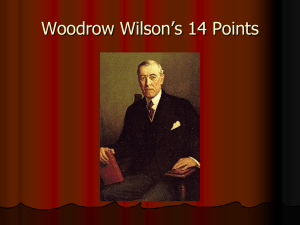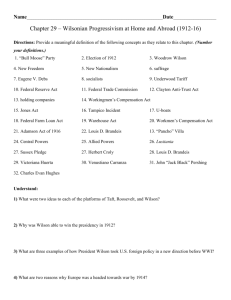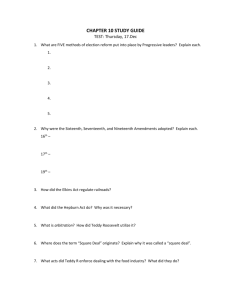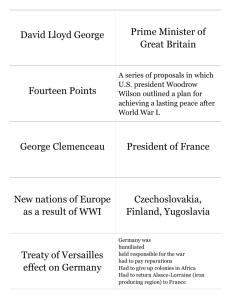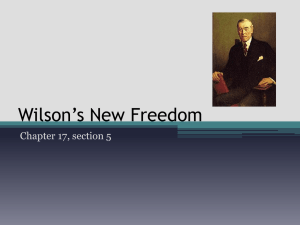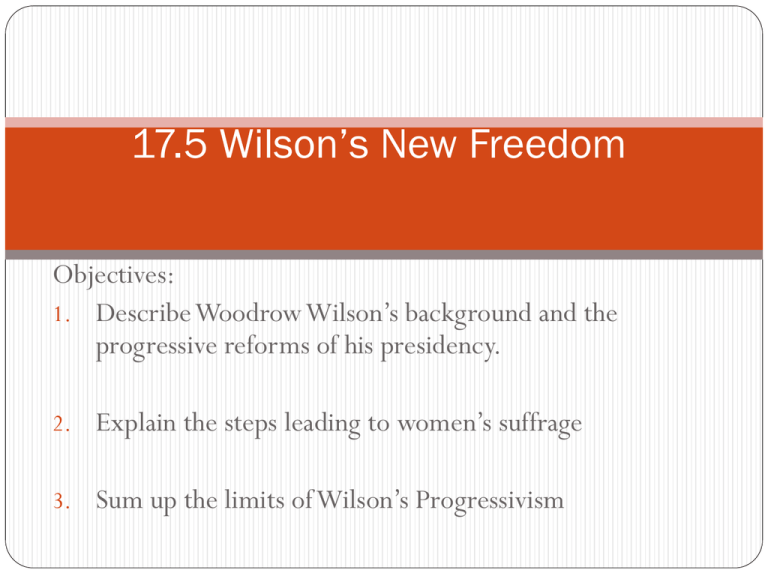
17.5 Wilson’s New Freedom
Objectives:
1. Describe Woodrow Wilson’s background and the
progressive reforms of his presidency.
2. Explain the steps leading to women’s suffrage
3. Sum up the limits of Wilson’s Progressivism
ELECTION OF 1912
Roosevelt loses Republican nomination
Roosevelt seizes Progressive Republican League from La Follette
and it becomes “Bull Moose” Party
Democrats nominate Woodrow Wilson
Wilson’s “New Freedom” v.TR’s “Square Deal”
(Wilson wanted to break up trusts, make govt. smaller)
Wilson elected by significant margin, but still as a MINORITY
president
REAL WINNER:
Progressivism
Map: Presidential Election, 1912
Presidential
Election, 1912
Though he won a
minority of the
popular votes,
Woodrow Wilson
captured so many
states that he
achieved an easy
victory in the
electoral college.
Wilson and Taft
Copyright © Houghton Mifflin Company. All rights reserved.
Wilson and Taft
Having just squared off in the 1912 election campaign, the two politicians share a
light moment before Wilson's inauguration on March 4, 1913. (Library of Congress)
Woodrow Wilson
Only 2nd Democratic President since 1861
Idealistic (hard to compromise – a problem later)
Reformer with popular appeal in era of party “machines”
Governor of NJ
Family ties with the South
Academic
President of Princeton
WILSON’S
“NEW FREEDOM”
=To attack the triple wall of privilege:
TRUSTS
TARIFFS
HIGH FINANCE
WILSON’S PROGRESSIVE AGENDA
TRUST-BUSTING:
Federal Trade Act, 1914
Federal Trade Commission
Clayton Anti-Trust Act, 1914
strengthen Sherman Anti-Trust Act
WILSON’S PROGRESSIVE AGENDA
A NEW TAX SYSTEM
( = REDUCE TARIFFS=LESS FEDERAL INCOME)
Underwood Tariff Bill (1913):
1st reduction since Civil War
Sixteenth Amendment:
Federal graduated income tax (starts at $4,000)
WILSON’S PROGRESSIVE AGENDA
HIGH FINANCE:
Federal Reserve Act creates Federal Reserve System.
(Fed. Government could now quickly adjust the amount of money in
circulation and make credit more available)
12 Regions with a federal reserve branch
Could help local banks that ran into trouble
WILSON’S
“NEW FREEDOM”
=To attack the triple wall of privilege:
TRUSTS
TARIFFS
HIGH FINANCE
Wilson said, “Without the watchful resolute
interference of the government, there can be no
fair play between individuals and the trust.”
How does this statement reflect Wilson’s approach
to reform? Support your answer.
http://www.reuther.wayne.edu/faces/WomenVoters.jpg
Woman Suffrage
Suffragettes gather in Downtown Detroit to advocate
participation in the League of Women Voters, c. 1920
Woman Suffrage
In 1910 Women could vote CATT’s STRATEGY:
in federal election only in
WY, UT, CO, ID
1. Highly organized
Suffragettes began
organizing women of all
classes
Carrie Chapman Catt,
national leader of NAWSA
(National Amer.Woman
Suffrage Assoc.)
2.
Close ties b/w local, state,
and natl. associations
3.
Cautious lobbying
4.
Lady-like behavior
RESULT:
Successes in WA, CA, KS, OR, and AZ
Failure in MI, OH, and WI
Election Day
Election Day
Critics of the woman-suffrage
movement, including this cartoonist,
believed that women's place was in the
home, not in the public sphere. (Library
of Congress)
Copyright © Houghton Mifflin Company. All rights reserved.
NEW TACTICS:
National Woman’s Party
Preceding the inauguration of Wilson there
Mrs. Carrie C. Catt addressing the Congress of
was a near riot as 5,000 women marched,
the International Women's Suffrage. 5/29/1923.
demanding the vote for women. The march was
Cleveland Public Library Photograph Collection
led by Alice Paul and Lucy Burns
http://www.cpl.org/suffrage/SUFFRAGE3.jpg
Steadfast Effort
Women’s continuous lobbying, and the combined
strategies of Catt and Paul, as well as women’s
contributions to WWI, finally pay off.
http://collections.ic.gc.ca/heirloom_series/volume3/chapter16/images/321-c.jpg
https://www.hosenose.com/ssl/goingpostal/search_results.asp?txtsearchParamTxt=landarmy2&txtsearchParamCat=5
4&txtsearchParamType=ALL&iLevel=1&txtsearchParamMan=ALL&txtsearchParamVen=ALL&txtFromSearch=
fromSearch&btnSearch.x=0&btnSearch.y=0
Nineteenth Amendment:
Granting Women Suffrage (1920)
TERMS
Clayton Antitrust Act
Objectives:
1.
Describe Woodrow
Wilson’s background and
the progressive reforms
of his presidency.
2.
Explain the steps leading
to women’s suffrage
3.
Sum up the limits of
Wilson’s Progressivism
Federal Trade Commission
Federal Reserve System
Nineteenth Amendment


